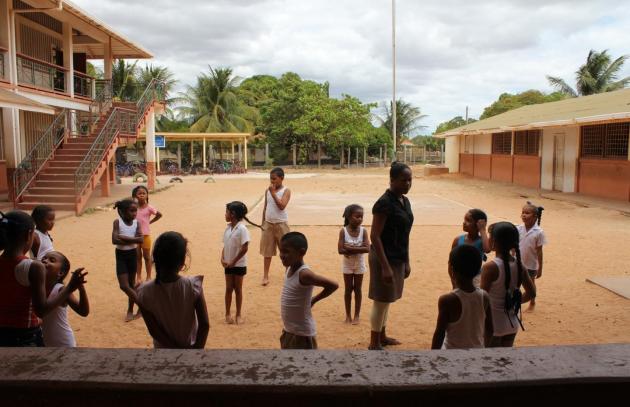picture_of_children_ministry_of_education_credit.jpg

In Guyana, floods are a familiar hazard, known to inundate communities – and schools – across the South American country every year. Fire, oil spills, drought, pollution, pandemics, and other natural and human-made hazards further threaten the stability of the education system. Faced with these recurrent challenges, Guyana’s education officials have created the first national risk management policy for the education sector.
In September 2020, officials from the Ministry of Education formed a dedicated team to create a blueprint for disaster risk reduction and management. While not specific to only COVID-19, the new policy was borne out of the realization that the country – like many others – was not ready for the disruption brought on by the pandemic.
“When COVID-19 came we realized how ill-prepared we were as an education system to face risks such as this pandemic,” says Nicola Johnson, the Chief Planning Officer in the Ministry of Education. “By creating a risk management policy, we could get the data and assess where the education system is in relation to the various types of risk and work to be able to reach the most vulnerable learners.”

At the onset of the pandemic, the Ministry moved quickly to close schools and shift to remote learning. However, many communities, especially in the hinterland and riverine areas, could not access digital learning, widening already existing disparities. This unprecedented situation – coupled with the growing threats of climate change – highlighted the urgency of developing capacities for risk management in education.
“Resilience is important for us because it can protect our most prized possession – human capital – and it facilitates the continuity of learning in times of crisis,” says Johnson.
The Ministry team – including central, sub-national, and education department heads – created risk profiles and hazard maps for all ten regions and the capital, Georgetown. From flooding to bushfires and drought, the team outlined who is at risk, where, and how, as well as the existing capacities and new strategies to help the education system not only cope, but build back stronger.
The Ministry took the lead in developing the risk management policy, with technical support from IIEP-UNESCO and UNICEF. This strategic decision enhanced the capacities of education managers so that they can successfully manage risks to the education system in the future.
Tackling risks head-on
Every year, schools in nine out of the ten regions in Guyana risk major disruption and damages to their facilities and learning equipment. This affects some 161,000 students and more than 10,500 teachers from nursery through to secondary school, according to the Annual Statistical Questionnaire as of July 2021. Girls and learners living in remote areas are especially susceptible to the effects of flooding because it can close hygiene facilities and access ways to schools.
In a given year, flooding affects more than 161,000 students and more than 10,500 teachers from nursery through to secondary school.
The policy consists of many measures to help the education system prevent, prepare for and respond to crises such as floods. While all of them are important, Johnson says they paid particular attention to strategies that focus on equity and reaching the most vulnerable learners.
“We really zoned in on actions that are associated with ensuring that access is dealt with during times of emergency,” she says. This includes everything from proper maintenance of education facilities and rehabilitation, identification of “safe” buildings in each district, teacher rosters, hazard-resilient storage equipment for teaching and learning materials, to the use of ICT tools to maintain crucial communication links during emergencies. It also involves strengthening the use of foreign indigenous languages to ensure that Venezuelan refugees and migrants whose first language is not English have access to education.
Risk-related data is key
The policy is also reshaping important planning tools like the Education Management Information System (EMIS) so that risk-related indicators are integrated. “This will help ensure that we have a fully developed and robust school mapping system in place,” says Johnson. “All of this can contribute to long-term efficiency and the way in which we can respond and mitigate risks in Guyana’s education system.”
To support the strengthening of the country’s EMIS, several members of the team also participated in an online course offered by IIEP-UNESCO and NORRAG in May-June 2021 on using data and information for crisis-sensitive educational planning. For eight weeks, the participants received in-depth training on the issues, tools, and strategic approaches to using data and information to prevent risks from having disastrous consequences on the education system.
“This training really brought home everything we did not know about data for risk management,” says Johnson.
Next steps
The education system is still in crisis mode and most schools remain partially closed because of COVID-19. Once schools are able to re-open, Johnson says the Ministry of Education will turn to the dissemination of the new risk management policy among schools, education leaders, and students. They are also working on aligning specific actions from the policy with the 2022 education budget to address risks head-on and protect education for all.
How does IIEP support ministries of education with risk management?
IIEP supports ministries of education throughout the world to develop plans for risk management, either as part of their education sector plans, or as stand-alone policies, as was done in Guyana. This process includes:
- Working sessions for the development of a risk analysis and risk reduction measures,
- Identification of targets and indicators for risk reduction,
- Support to cost the implementation of the planned risk reduction measures.
IIEP’s technical cooperation can be provided face-to-face (when COVID allows), and virtually and consists of:
- Reviewing existing processes and tools to develop alternative and/or improved strategic planning processes,
- Offering feedback and comments on drafts of various documents,
- Discussing the various steps in the process of developing national policy frameworks,
- Organizing and moderating national discussions,
- Providing relevant examples from other contexts confronted with similar challenges,
- Providing technical and strategic advice.





